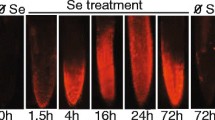Abstract
Physiological dormancy of scarified seeds of Townsville stylo (Stylosanthes humilis H.B.K.) was released by seleno-L-methionine (SeM), but not by L-methionine. This regulating effect was impaired by inhibitors of ethylene biosynthesis and action; in the first case SeM action was restored by 2-chloroethylphosphonic acid (CEPA) and 1-aminocyclopropane-1-carboxylic acid (ACC). The Se-aminoacid proved to be toxic in a time-dependent manner to seedling growth, inhibiting primarily the hypocotyl expansion. This toxicity is suggested to trigger ethylene biosynthesis, which would promote germination of dormant seeds.
Similar content being viewed by others
References
Ballard L.A.T., Buchwald T. 1971. A viability test for seeds of Townsville stylo using thiourea. Aust. J. Exp. Agr. Anim. Husb., 11: 207–210.
Burin M.E., Barros R.S., Rena A.B. 1987. Chemical regulation of endogenous dormancy in seeds of Stylosanthes humilis H.B.K. Turrialba, 37: 281–285.
Burnell J.N. 1981. Selenium metabolism in Neptunia amplexicaulis. Plant Physiol., 57: 316–324.
Delatorre C.A., Barros R.S. 1996. Germination of dormant seeds of Stylosanthes humilis as related to heavy metal ions. Biol. Plant., 38: 269–274.
Eustice D.C., Kull F.J., Shrift A. 1981a. Selenium toxicity: aminoacylation and peptide bond formation with selenomethionine. Plant Physiol., 67: 1054–1058.
Eustice D.C., Kull F.J., Shrift A. 1981b. In vitro incorporation of selenomethionine into protein by Astragalus polysomes. Plant Physiol., 67: 1059–1060.
Holm A.McR. 1972. The effect of high temperature pretreatments on germination of Townsville stylo seed material. Aust. J. Exp. Agri. Anim. Husb., 13: 190–192.
Jones J.F., Kende H. 1979. Auxin-induced ethylene biosynthesis in subapical stem sections of etiolated seedlings of Pisum sativum L. Planta, 146: 649–656.
Kende H. 1993. Ethylene biosynthesis. Annu. Rev. Plant Physiol. Plant Mol. Biol., 44: 283–307.
Konze J.R., Kende H. 1979. Interactions of methionine adenosyltransferase and ethylene-generating systems. Plant Physiol., 63: 507–510.
Konze J.R., Schilling N., Kende H. 1978. Enhancement of ethylene formation by selenoaminoacids. Plant Physiol., 62: 397–401.
Mattoo A.K., Baker J.E., Moline H.E. 1986. Induction by copper ions of ethylene production in Spirodela oligorrhiza: evidence for a pathway independent of 1-aminocyclopropane-1-carboxylic acid. J. Plant Physiol., 123: 193–202.
Mattoo A.K., Mehta R.A., Baker J.E. 1992. Copper-induced ethylene biosynthesis in terrestrial (Nicotiana tabacum) and aquatic (Spirodela oligorrhiza) higher plants. Phytochemistry, 31: 405–409.
Miller E.R., Lei X., Ullrey D.E. 1991. Trace elements in animal nutrition. In (eds): Mortvedt J.J., Cox F.R., Schuman L.M., Welch R.M. Micronutrients in Agriculture. Pp. 593–662. N4, Book Series, Soil Science Society of America, Madison.
Neuhierl B., Böck A. 1996. On the mechanism of selenium tolerance in selenium-accumulating plants. Purification and characterization of a specific selenocysteine methyltransferase from cultured cells of Astragalus bisculatus. Eur. J. Biochem., 239: 235–238.
Ouannès C., Wilson T. 1968. Quenching of singlet oxygen by tertiary aliphatic amines. J. Amer. Chem. Soc., 90: 6527–6528.
Reid M.S., Paul J.L., Farhoomand M.B., Kofranek A.M., Staby G.L. 1980. Pulse treatments with the silver thiosulfate complex extend the vase life of cut carnations. J. Amer. Soc. Hort. Sci., 105: 25–27.
Scott A.J., Knott M. 1974. A cluster analysis for grouping means in the analysis of variance. Biometrics, 30: 507–512.
Tappel A.L. 1965. Free-radical lipid peroxidation damage and its inhibition by vitamin E and selenium. Fed. Proc., 24: 73–78.
Vieira H.D., Barros R.S. 1994. Responses of seed of Stylosanthes humilis to germination regulators. Physiol. Plant., 92: 17–20.
Welch R.M., Allaway W.H., House W.A. Kubota J. 1991. Geographic distribution of trace element problems. In (eds): Mortvedt J.J., Cox F.R., Schuman L.M., Welch R.M. Micronutrients in Agriculture. Pp. 31–57. N 4, Book Series, Soil Science Society of America, Madison.
Author information
Authors and Affiliations
Rights and permissions
About this article
Cite this article
Barros, R.S., de Paula Freitas, A.W. Selenomethionine as a dormancy-breaking agent in seeds of Stylosanthes humilis . Acta Physiol Plant 23, 279–284 (2001). https://doi.org/10.1007/s11738-001-0034-9
Received:
Accepted:
Issue Date:
DOI: https://doi.org/10.1007/s11738-001-0034-9




